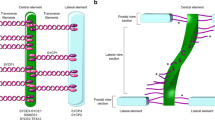Abstract
A method is described for the silver staining of the synaptonemal complex in surface-spread mammalian spermatocytes for light microscope examination. The method is quick, reliable, of broad applicability, and provides a means of making karyotype analysis at meiotic prophase. Many hundreds of suitable cells can be examined in an average preparation in a relatively short space of time. It has so far been applied only to mammalian spermatocytes, but could be used for karyotype analysis in oocytes of mammals and also applied to gonocytes of non-mammalian species.
Similar content being viewed by others
References
Chandley, A.C., Jones, R.C., Dott, H.M., Allen, W.R., Short, R.V.: Meiosis in interspecific equine hybrids. 1. The male mule and hinny. Cytogenet. Cell Genet. 13, 330–341 (1974)
Counce, S.J., Meyer, G.F.: Differentiation of the synaptonemal complex and the kinetochore in Locusta spermatocytes studied by whole mount electron microscopy. Chromosoma (Berl.) 44, 231–253 (1973)
Elsevier, S.M., Ruddle, F.H.: Location of genes coding for 18S and 28S ribosomal RNA within the genome of Mus musculus. Chromosoma (Berl.) 52, 219–228 (1975)
Esponda, P., Stockert, J.C.: Localization of the synaptonemal complex under the light microscope. Chromosoma (Berl.) 68, 83–90 (1978)
Evans, E.P., Beechey, C.V., Searle, A.G.: Male sterile translocations. Private communication. Mouse News Letter 57, 17 (1977)
Evans, E.P., Breckon, G., Ford, C.E.: An air-drying method for meiotic preparations from mammalian testes. Cytogenetics 3, 289–294 (1964)
Ferguson-Smith, M.A., Page, B.M.: Pachytene analysis in a human reciprocal (10; 11) translocation. J. med. Genet. 10, 282–287 (1973)
Hungerford, D.A., Hungerford, A.M.: Chromosome structure and function in man. VI. Pachytene chromomere maps of 16, 17 and 18; pachytene as a reference standard for metaphase banding. Cytogenet. Cell Genet. 21, 212–230 (1978)
Hungerford, D.A., Mellman, W.J., Balaban, G.B., La Badie, G.U., Messatzzia, L.R., Haller, G.: Chromosome structure and function in man. III. Pachytene analysis and identification of the supernumerary chromosome in a case of Down's syndrome (Mongolism). Proc. nat. Acad. Sci. (Wash.) 67, 221–224 (1970)
Miller, D.A., Miller, O.J.: Chromosome mapping in the mouse. Science 178, 949–955 (1972)
Moses, M.J.: Microspreading and the synaptonemal complex in cytogenetic studies. In: Chromosomes today 6, 71–82 (1977a)
Moses, M.J.: Synaptonemal complex karyotyping in spermatocytes of the Chinese Hamster (Cricetulus griseus). I. Morphology of the autosomal complement in spread preparations. Chromosoma (Berl.) 60, 99–125 (1977b)
Moses, M.J.: Synaptonemal complex karyotyping in spermatocytes of the chinese hamster (Cricetulus griseus). II. Morphology of the XY pair in spread preparations. Chromosoma (Berl.) 60, 127–137 (1977c)
Moses, M.J., Counce, S.J., Paulson, D.F.: Synaptonemal complex complement of man in spreads of spermatocytes, with details of the sex chromosome pair. Science 187, 363–365 (1975)
Moses, M.J., Russell, L.B., Cacheiro, N.L.A.: Mouse chromosome translocations: visualization and analysis by electron microscopy of the synaptonemal complex. Science 196, 892–894 (1977)
Noel, B., Quack, B., Benezech, M.: Le bivalent sexual des mammifères observé par marquage argentique au stade pachytène. Ann. Genet. (Paris) 21, 83–87 (1978)
Ohno, S., Kaplan, W.D., Kinosita, R.: Heterochromatic regions and nucleolus organizers in chromosomes of the mouse, Mus musculus Exp. Cell Res. 13, 358–364 (1957)
Quack, B., Noel, B.: The XY chromosome pair in mouse and human spermatocytes, visualized by silver staining. Nature (Lond.) 267, 431–433 (1977)
Searle, A.G., Beechey, C.V., Evans, E.P.: Meiotic effects in chromosomally derived male sterility of mice. Ann. Biol. anim. Biochem. Biophys. 18, 391–398 (1978)
Tres, L.L.: Extensive pairing of the XY bivalent in mouse spermatocytes as visualized by whole-mount electron microscopy. J. Cell Sci. 25, 1–15 (1977)
Author information
Authors and Affiliations
Rights and permissions
About this article
Cite this article
Fletcher, J.M. Light microscope analysis of meiotic prophase chromosomes by silver staining. Chromosoma 72, 241–248 (1979). https://doi.org/10.1007/BF00293237
Received:
Accepted:
Issue Date:
DOI: https://doi.org/10.1007/BF00293237




